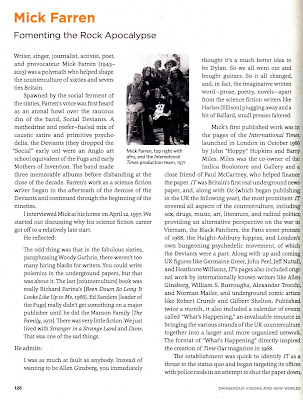Book Review: 'Dangerous Visions and New Worlds: Radical Science Fiction, 1950-1985'
edited by Andrew Nette and Iain McIntyre
3 / 5 Stars
Dangerous Visions and New Worlds: Radical
Science Fiction, 1950-1985 (224 pp.) was published by PM Press in November, 2021. Both hardcover and trade paperback editions are available from PM, a firm devoted to publishing Marxist agitprop (?!)
As with the other volumes in the series, Dangerous Visions is a nicely produced, quality trade paperback with high-resolution scans and photographs of over a hundred paperback books. These accompany twenty essays on ‘progressive’ science fiction published during the interval from 1950 to 1985.
The essays cover a variety of topics, including the works of the black, female writer Octavia Butler; the pornographic sci-fi and fantasy novels issued by the 1960s smut publisher Essex House; nuclear war as viewed by sci-fi writers during the 1960s and 1970s; psychological themes in the works of Philip K. Dick; and the antihero narrative expressed in Roger Zelazny’s 1969 novel ‘Damnation Alley’.
While co-authors Nette and McIntyre contribute the majority of the essays, there are contributions from members of Academia, fiction writers, and critics of pop literature and pop culture.
Needless to say, with the participation of affiliates of Academia, identity and grievance politics and sententious remarks (decrying all manner of -isms) color almost every paragraph of some of the contributions to Dangerous Visions.
One also must gird for a steady diet of pretentious gobbledygook; for example, I witnessed the phrases ‘phallocentric weapons culture’, ‘intersectional feminist text’, ‘protoplasmic porridge’, ‘intertextual resonances’, and ‘puritanical rectitude’. After reading these phrases, I felt as if I had automatically qualified for an M.A. in Modern and Contemporary Literature, without having to accrue $125,000 in student loan debt.
And within the pages of Dangerous Visions I encountered, for the first time in my life, the verbs ‘reterritorialize’ and 'minoritize', gems of jargon so precious and rare that I am forever holding them in reserve for such time as I submit a manuscript to the PMLA……
It’s also apparent that many of the essays in ‘Dangerous Visions’ strain mightily to imbue the profiled novels with a sociopolitical profundity that such novels may not really deserve. For example, in an essay on Ira Levin’s 1972 novel ‘The Stepford Wives', the essay's author declares:
….it is actually a very sophisticated story, containing perceptive observations about the backlash against second-wave feminism, patriarchal control of women’s bodies, and the way in which intelligent women can be gaslit and psychological destroyed by the men around them.
And here I thought ‘Stepford’ was an entertaining satire of suburbia and its fixation with consumerism……….!
These criticisms aside, there are some informative and well-written essays in Dangerous Visions, such as Erica L. Satifka’s piece on Philip K. Dick, Mike Stax’s piece on Mick Farren, Molly Grattan's piece on apocalyptic novels for the Young Adult readership, and Michael Gonzalez’s piece on Octavia Butler.Who will want to get a copy of Dangerous Visions ? Well, I expect Joachim Boaz and his followers at the 'Science Fiction and Suspect Ruminations' blog will find it engaging (Boaz actually was approached by Nette to contribute the book, but was too pressed with other commitments to take him up on the offer).
I am more ambivalent about recommending it to Justin Marriott's 'Paperback Fanatics' and allied persons. I can't see the text pieces in Dangerous Visions holding much appeal for people outside Academia.
However, the scans and photos of the paperbacks are certainly going to aid said Fanatics in adding to their collections (with the ever-mindful caveat that many of these paperbacks now have exorbitant asking prices), so in that regard, I am comfortable with giving Dangerous Visions a 3 out of 5 Star score.









Great review, tarbandu—substantial, useful and fun. Thanks!
ReplyDelete